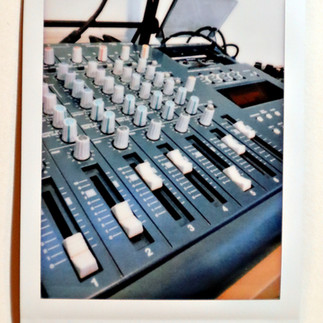
In March 2022, I began my "post-digital development" research and creation project funded by the Canada Council for the Arts. I documented this work through 6 videos on my YouTube channel, the playlist of which is here. I also recorded the tools of this new practice on Instax instant film, the gallery of which is below!
Summary
In this project I developed a post-digital solo saxophone practice in which I harnessed the noise, limitations, and material nature of various analogue media, combined with the saxophone.
For the majority of the project, I was guided in lessons with ambient/cassette master AMULETS, who helped me with technical equipment issues, composition and performance philosophy, and a concert critique. With his guidance, and following the impetus to develop an efficient performance setup, I fashioned a “loopcase” from my grandmother’s suitcase to house my tape looping gear. Its vintage-ness, portability, and analogue contents are a metaphor for my post-digital philosophy: that there is still much to be explored in the material world around us, a world that impacts us far differently than the digital one.
This practice is not simply anti-digital, but rather questions its ubiquity. To meaningfully employ digital media, I recorded, mixed, and edited six videos for YouTube. In stark contrast to the scrolling, ephemeral content of platforms such as Instagram, each of these long form pieces/videos communicate how certain equipment and techniques are used in real musical practice.
While much of the equipment I engaged with related to ambient music, I aimed to integrate highly technical saxophone playing from my performance background. For example, to play along with the electromagnetic signal of one tape machine, I had to perform in the key of F1/4# using with a special set of fingerings on the saxophone. Such a challenging approach eschews the flexibility of digital technology to push the boundaries of instrumental technique and embrace the idiosyncrasies of physical media.
This project expanded my use of acoustic feedback. While my academic work in feedback saxophone had been necessarily narrow, throughout this work I used feedback as an indeterminate element in electroacoustic improvisations and added a range of effects to widen its impact.
I used hand-made tape loops in a variety of recorders where I also employed “sound on sound” overdubbing, as well as creative patching and amplification. Connecting devices to an electromagnetic pickup and contact mic amplified their electromechanical properties and expanded their use as instruments. Furthermore, patching the MT-50 4-track recorder into itself, I could also produce a wide range of internal feedback pitches (“no-input” mixing) that could be manipulated and modified.
As part of this practice, I also advanced my audio mixing and video editing skills. Through releasing videos on YouTube, I have established a small following and have been able to share this new work with my existing fanbase. During this project’s timeline, I also presented some of its results at Bleep in the Dark in Halifax, the Canadian Music Centre in Toronto, Sound Symposium in St. John’s, and OK LA in Verdun. These performances, while taking time away from the project, were invaluable to help shape the direction of it.
When this project began, I knew I wanted to spread out the work over a longer time period. Between the performances, the intensity of my thesis writing, and my video editing computer dying, this project ended up bleeding into the new year. My thesis work also exhausted my writing energy for this project, hence no blog posts until now, and I am still navigating how to integrate photography into my practice.
I am eager to continue this exciting practice, as I believe I have just scratched the surface. I am planning on recording a solo album this year, so please stay tuned!

.jpg)

































































































